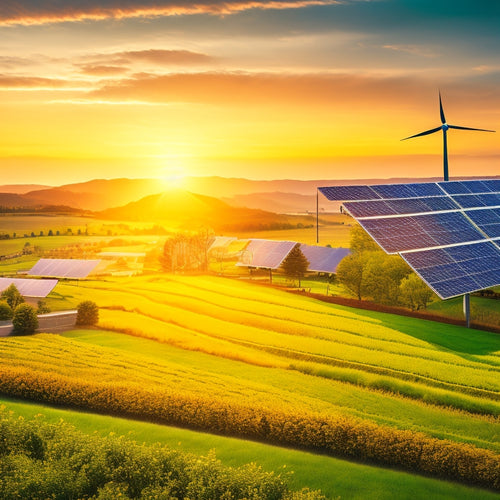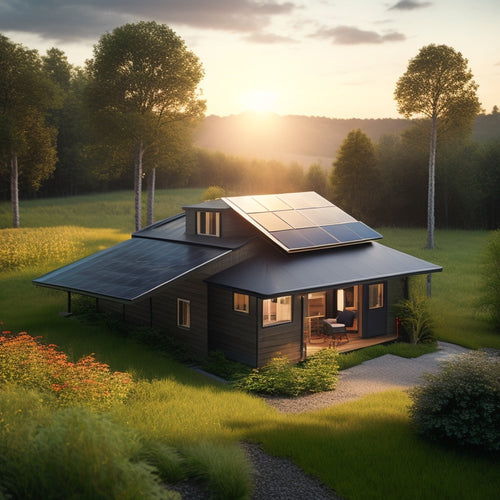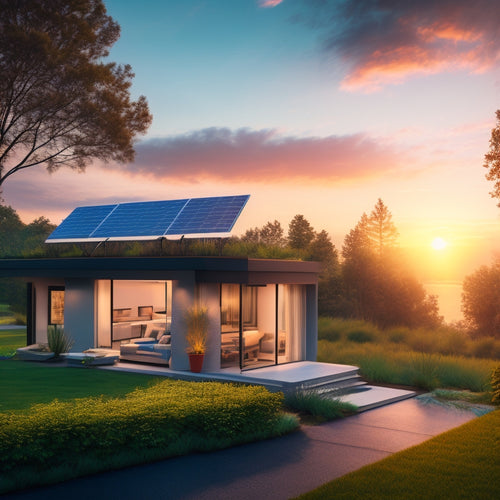
Why Panels Fail Efficiency Tests
Share
You invest in solar panels expecting them to convert sunlight into energy efficiently, but a significant percentage fail to meet efficiency standards due to various reasons. Manufacturing defects, insufficient quality control, and inadequate materials are just a few culprits, highlighting the need for rigorous testing and supplier audits. Poor design, environmental factors, and installation flaws also contribute to efficiency failures. Additionally, outdated technology and standards can limit innovation and improvement. As you investigate these factors, you'll reveal the intricacies behind panel inefficiencies and identify opportunities to optimize your solar panel system's performance.
Overview
- Manufacturing defects account for 20% of solar panel efficiency test failures, often due to material selection or assembly issues.
- Inadequate quality control measures allow defects to persist undetected, emphasizing the need for regular supplier audits and rigorous testing protocols.
- Material quality and design considerations significantly impact panel performance, with subpar materials and design flaws leading to reduced energy output.
- Environmental factors such as dust accumulation, shading, and structural stress can reduce solar panel efficiency by up to 25%, highlighting the importance of proper installation and maintenance.
- Outdated technology and legacy system limitations restrict efficiency improvements, necessitating innovation and upgrading to accommodate advancements in solar technology.
Manufacturing Defects and Flaws
Approximately 20% of panels fail efficiency tests due to manufacturing defects and flaws.
Environmental stress tests and accelerated life testing simulate extreme conditions to evaluate solar panel durability, and reliable metrics like MTBF (Mean Time Between Failures) and MTTF (Mean Time To Failure) gauge panel performance over time reliable metrics.
As you assess the root cause, you'll likely find issues with manufacturing processes, material selection, or assembly techniques.
Defect detection is vital to quality assurance, and it's important to identify flaws early on to optimize production efficiency.
You can improve testing protocols by implementing stricter quality control measures and refining process optimization strategies.
By doing so, you'll reduce the likelihood of defects making it to the final product.
Insufficient Quality Control Measures
As you refine your defect detection strategies, it's clear that insufficient quality control measures are a significant contributor to panel failures.
Without strong quality assurance, testing protocols can be inadequate, allowing defects to slip through. Inspection techniques may not be thorough, and certification standards may not be met.
In fact, component-level failure analysis has shown that faulty components, such as cracked solar cells and weak interconnects, can lead to panel failures.
Furthermore, environmental stress screening and accelerated life testing can help identify potential failure modes and estimate product lifespan.
To optimize your process, you must conduct regular supplier audits to guarantee compliance.
Defect tracking and performance metrics can help identify areas for improvement.
Inadequate Materials and Design
Your solar panels' performance hinges on the quality of their constituent parts and the design that brings them together. When manufacturers cut corners on material selection, it can lead to subpar performance. Inadequate design refinement can result in compromised thermal performance, affecting energy output.
Durability testing is vital to guarantee structural integrity, but some manufacturers may skip this step to reduce costs. Material compatibility is also significant, as mismatched components can reduce efficiency. The cost of solar battery storage systems, ranging from $5,000 to $15,000 or more solar battery costs, can be a significant investment, making it imperative to prioritize quality materials and design.
Staying on top of innovation trends can help you avoid panels with outdated designs. Aesthetically pleasing panels may look great, but if they're made with inferior materials, they won't perform well. By prioritizing quality materials and design, you can enjoy maximum energy production and freedom from reliance on the grid.
Environmental Factors and Stress
Environmental factors and stress can greatly impact your solar panels' efficiency. You need to evaluate the external conditions that can affect your panels' performance. Temperature fluctuations, humidity levels, and solar irradiance can all impact energy output.
| Environmental Factor | Impact on Efficiency | Solutions |
|---|---|---|
| Dust accumulation | Reduces energy output by up to 25% | Regular cleaning and coating with hydrophobic materials |
| Wind exposure | Increases structural stress, reducing lifespan | Secure mounting and reinforced frames |
| Shading effects | Reduces energy output by up to 10% | Enhance panel placement and tree pruning |
Additionally, geographic variability, extreme weather, pollution impact, and environmental degradation can all contribute to reduced efficiency. It is crucial to evaluate these factors when installing and maintaining your solar panels to guarantee maximum energy production.
Inefficient Cell Configuration Design
You'll often find that inefficient cell configuration design is a major contributor to panel inefficiency.
Specifically, you'll want to examine cell spacing errors, inadequate wiring design, and poor busbar placement, as these flaws can greatly reduce energy output.
Cell Spacing Errors
Across various solar panel assemblies, inefficiencies often stem from inadequate cell spacing, which compromises the overall energy output. You might assume that cells are uniformly spaced, but that's not always the case. In reality, incorrect cell alignment and inadequate spacing optimization can greatly reduce energy production.
| Cell Spacing Error | Energy Output Impact | Solution |
|---|---|---|
| Insufficient spacing | 5-10% energy loss | Increase spacing to 2-3 mm |
| Misaligned cells | 3-5% energy loss | Implement precision cell alignment |
| Inconsistent spacing | 2-3% energy loss | Optimize spacing using simulation tools |
Inadequate Wiring Design
Solar panel wiring design flaws, an essential bottleneck, can greatly impede energy production.
You might be surprised to learn that inefficient circuit configurations can reduce your panel's overall efficiency by up to 10%. This is because complex circuits can lead to uneven load balancing, causing some cells to work harder than others. As a result, the entire panel's energy output suffers.
To avoid this, it's vital to enhance your wiring design for simplicity and balance. By doing so, you'll guarantee that each cell operates within its ideal parameters, maximizing your panel's energy production.
Poor Busbar Placement
Optimizing wiring design is just the beginning.
Now, you need to focus on busbar placement, a critical aspect of inefficient cell configuration design. Poor busbar placement can greatly reduce your panel's efficiency. When busbars are misaligned, electrical conductivity suffers, leading to energy losses.
You must guarantee precise busbar alignment to minimize resistance and maximize energy flow. A well-designed busbar system allows for efficient current distribution, reducing heat generation and increasing overall panel performance.
Don't underestimate the impact of poor busbar placement – it can be the difference between passing and failing efficiency tests.
Poor Installation and Maintenance
During the efficiency testing of panels, a significant number of them fell short of expectations due to poor installation and maintenance practices.
You might be surprised to learn that improper installation techniques can lead to reduced panel performance. For instance, incorrect tilt and orientation can result in lower energy output.
Additionally, neglecting regular maintenance schedules can cause panels to degrade faster, reducing their overall efficiency.
It's essential to guarantee that panels are installed using proper techniques and maintained according to the manufacturer's recommended schedules.
Outdated Technology and Standards
You're likely aware that outdated specs are still in place, hindering efficiency improvements.
These old standards were established when legacy systems were the norm, and they've yet to be updated to accommodate modern technology.
As a result, you're limited by the constraints of these outdated systems, which can greatly impact overall performance.
Old Specs In Place
Old Specs In Place (Outdated Technology and Standards)
You're likely familiar with the frustration of dealing with outdated technology and standards. The specifications that governed the development of your panel were set years ago, and they haven't been updated to reflect current advancements.
This means your panel is stuck with old, inefficient designs that don't meet modern efficiency standards. Specification updates are long overdue, but regulatory compliance often hinders progress.
As a result, your panel fails efficiency tests, and you're left struggling to keep up with the competition. It's time to acknowledge that these outdated specs are holding you back and demand change.
Legacy System Limitations
The outdated specs governing your panel's development have set a low bar for efficiency, and now it's time to examine the legacy system limitations that are perpetuating these inefficiencies.
Your panel's system design is riddled with performance bottlenecks, compatibility issues, and software limitations that hinder its ability to operate efficiently. Upgrading your system is an intimidating task, requiring significant user training and integration efforts.
Furthermore, data management becomes a nightmare, leading to operational inefficiencies and support constraints. These limitations not only affect your panel's performance but also restrict your freedom to innovate and improve.
It's crucial to acknowledge these constraints and work towards overcoming them to achieve true efficiency.
Frequently Asked Questions
Can Panel Efficiency Be Improved After Installation?
You can improve panel efficiency after installation by implementing post-installation upgrades, such as cleaning or replacing components, and utilizing performance monitoring tools to identify areas for optimization, ultimately maximizing energy output and your freedom from grid dependence.
How Often Should Panels Be Cleaned for Optimal Performance?
As you release the full potential of your solar panels, remember that regular cleaning is key: aiming for a quarterly cleaning frequency, you'll want to schedule maintenance every 3-4 months to guarantee peak performance, unshackling your energy from dust and debris.
Do Energy-Efficient Panels Really Make a Difference?
You invest in energy-efficient panels, leveraging advanced panel technology to maximize energy savings. Yes, they make a significant difference, generating more power per hour of sunlight, and reducing your reliance on the grid, giving you more freedom and independence.
Are All Solar Panels Compatible With Energy Storage Systems?
You'll find that not all solar panels are created equal when it comes to energy storage compatibility. Different solar panel types, such as monocrystalline and thin-film, have varying levels of compatibility with energy storage systems, so it's crucial to choose the right combo for your freedom-driven goals.
Can Solar Panels Be Recycled at the End of Their Life?
You'll be glad to know that, yes, solar panels can be recycled at the end of their life, reducing waste and environmental impact through responsible recycling processes that recover precious materials like silicon and metals.
Ready to Buy
As you steer through the complex world of solar panels, it's clear that efficiency tests can be a minefield. Manufacturing defects, insufficient quality control, and inadequate materials are just a few of the pitfalls that can lead to failure. It's like trying to build a house on shaky ground - without a solid foundation, the entire structure comes crashing down. By understanding these common pitfalls, you can avoid the mistakes that leave solar panels in the dark.
Related Posts
-

Net Metering in Renewable Energy's Future
Net metering's future is vital for driving renewable energy growth and financial savings. You can reduce your electri...
-

Diy Off Grid Solar
By embracing DIY off-grid solar, you can break free from grid dependence, slashing your energy bills by up to 90% and...
-

The Future of Residential Energy Storage
The future of residential energy storage looks promising and cost-effective for you. With lithium-ion battery prices ...


